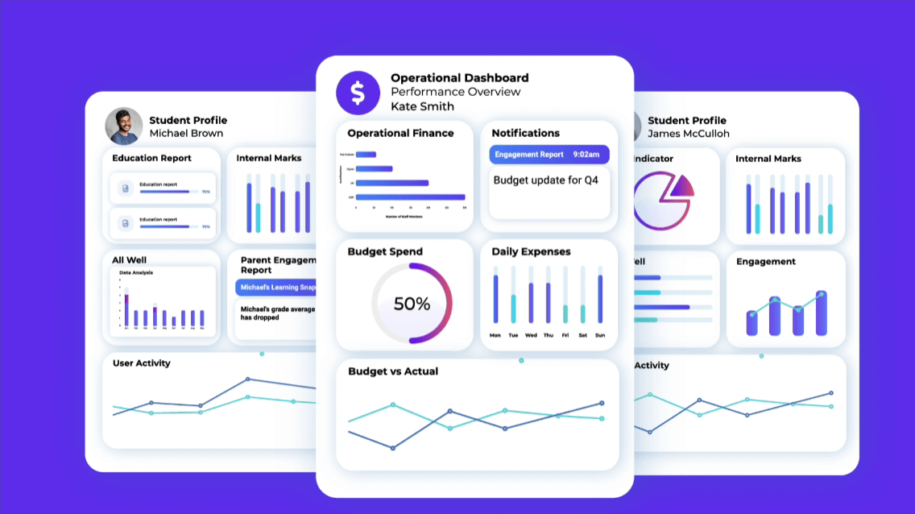Learning analytics is a powerful tool for educational institutions. Technology allows for the collection and reporting of all data about learners and teachers in ways that can enable educators and administrators to make better decisions and achieve better student outcomes.
When you add data visualization to existing data sets from LMS and SIS you create powerful ecosystems connected by data that can help teachers rather than hinder them. Educators should be empowered with all tools necessary to upgrade their own teaching and learning, and therefore help their students’ learning in whichever way the students need. “Big data” is not only for businesses: it is essential for schools as well.
Formally, “learning analytics” was defined in 2011 at the first International Conference on Learning Analytics and Knowledge (LAK), run by the Society for Research in Learning Analytics (SoLAR):
Learning analytics is the measurement, collection, analysis and reporting of data about learners and their contexts, for purposes of understanding and optimizing learning and the environments in which it occurs.
There are three key kinds of learning analytics:
- Descriptive analytics, which focuses on current and past data to evaluate students over time
- Diagnostic analytics, which focuses on the relationship between data, answering questions like “why did this happen?”
- Predictive and prescriptive analytics, which focuses on using data to surface insights as to future performance and the best path for the future.
Why is learning analytics important?

While people have been researching ways to improve learning and teaching for a long time, we are now at the point where we can use technology to assist in the research. Learning analytics tools are designed to process and visualize massive amounts of educational data – data that holds the key to improving individual and group student performance and outcomes.
Collecting data serves little purpose. It is when data is analysed and reported in easy-to-understand methods that educators can confidently assess the effectiveness of their teaching, the performance of their students, and the best path forward for themselves and their students.
The best part is that we know the education industry can move quickly to adapt to necessary change. The industry’s response to the COVID-19 pandemic in 2020 and 2021, adjusting curricula from virtual to hybrid and back again, has proved just how fast we can reinvent instruction.
Educators and their institutions have proven they’re capable of anything when it comes to better outcomes for their students and themselves.
Learning analytics can be deployed for K-12 schools of all kinds, as well as higher education institutions, and vocational schools and training.
Why is learning analytics important for K-12?
Kindergarten to Year 12 or the equivalent primary and secondary educational years are formative for students. Using learning analytics to assess and aid students in this developmental period will provide a data-driven path to make students more competent, confident and skilled.
Learning analytics provide actionable insights to teachers. These insights can help improve course material, teaching methods, and the customisation of these to the needs of particular students.
The importance of personalized attention at this influential time in a student’s life cannot be understated. Every student’s learning journey is different. The best edtech software and learning management systems will enable teachers to provide the kind of personalized attention and customized methods that students need to succeed.
Why is learning analytics important for higher education?
For universities and higher education institutions, learning analytics is a great tool for educators and administrators to track and analyse the performance of their programs as well as their students.
It can be the key to institutions transforming and future-proofing themselves.
With improved understanding of available data, institutions reduce attrition rates by predicting both student success and the possibility of students failing or dropping out.
Additionally, with the increase in online learning in educational institutions of all kinds, learning analytics will continue to grow in importance.
By analysing existing data around online courses, institutions and educators can help current and future students achieve higher grades and engage more meaningfully with course content.
There are massive amounts of data available at faculty, student and course levels about current and past student performance. This means there are an untold number of opportunities available for predicting the future of higher education institutions, their programs and their cohorts.
Why is learning analytics important for vocational education?
Vocational education is vital for preparing students with skills for specific workplaces. Learning analytics can and should be used to enhance the planning and delivery of course material in vocational education. It can also unlock insights into not only current student performance, but also their history throughout their training, and predictions about their future performance.
The actionable insights available to course directors and educators are key to personalizing learning to individual learners. Just like in K-12 and higher education, every vocational student learns differently. By tracing and analysing individual and group educational data, and visualising the important information in the results, teachers and students can access feedback about their progress.
The actionable nature of the insights means that this feedback can be turned into real advice and tips for how students can enhance and improve their learning and workplace skills.
Insights from data analytics and business intelligence in vocational education are also critical for attracting the right students to the right courses.
Completion rates are a top priority for vocational institutions.
Learning analytics helps to mitigate student drop out or fail rates by identifying risk patterns and enabling early intervention.
It can also inform enrolment strategy, bolster orientation experiences and improve strategic decision making that saves vocational institutions time and money
What are the benefits of learning analytics?

There are many benefits of learning analytics for people involved in education at all levels, from the Department of Education, to researchers, to educators and administrators, to students and parents. Essentially, learning analytics is a tool that can be used to help teachers and students understand a student’s performance and determine the best path to success in the future.
Educational institutions that use learning analytics to their best advantage often also find that they are able to:
- Support the development of lifelong learning for students and teachers
- Provide meaningful, personalized and timely feedback to students, teachers and parents
- Develop quality learning and teaching by providing data-backed evidence of what works
- Predict student success and identify troubles before they become critical
- Plan for the future by uncovering the methods and materials students engage with best
- Empower online learning methods by making use of all the available data
Institutions generate terabytes worth of data every day. This is an asset that cannot be wasted. Learning analytics tools are designed to help you make the most of your data.




